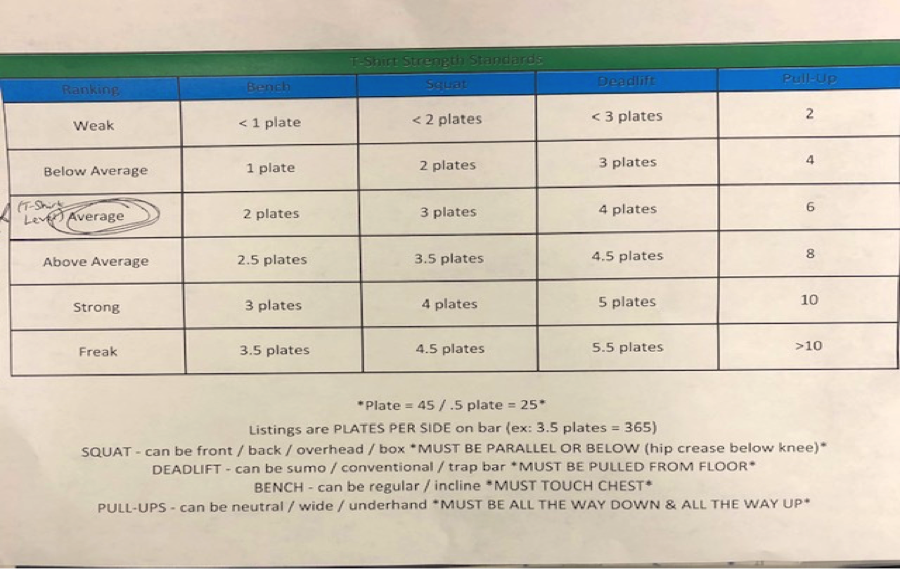
I made this chart a few years ago during Spring Training. (To be honest, the first version of this had the “Average” category where the current “Above Average” category was. Apparently the average male benching 275, squatting 365, deadlifting 455, and doing 8 pull-ups was blasphemous). Anyways, we would hand out shirts every year to our players for passing our strength and conditioning standards. I wanted to find a justifiable way to award shirts to our coaches who lift in the morning as well, instead of just openly handing them the shirts. So I put together this little chart (it was never actually utilized, but I still think it could be a meaningful guide to see where you stand).
A couple of disclaimers here before people lose their minds.
- This is NOT a chart for athletes. As the title of the article states, this is simply a chart for the recreational male lifter.
- I understand the value of unilateral work, conditioning, Olympic lifts, etc. Again, this chart was made more for fun than anything else and should not be taken as gospel in any way, shape, or form.
- I understand some people have preferences on lifts, which is why I included variations (trap bar vs. conventional vs. sumo for instance). Just find the one you like and try to hit a solid number.
- I understand that everyone has a different build and that heights, weights, etc. do matter. If you want to justify your numbers by adjusting for all this go right ahead. I’ve hung around a dude who squatted 500+ at 185 and a dude who pulled 500+ at sub-160. In this particular instance, your build means nothing to me.
Okay with all of that out of the way let’s dive into the chart. It should be straightforward to read and understand, but some of the basics here:
- A “plate” is a 45 lb. plate and a “.5 plate” is a 25 lb. plate. Each listing is plates PER SIDE of the implement you are using. So if it says 2.5 plates that means you have two 45’s per side and one 25 per side (aka 275).
- To earn a shirt, you’d essentially have to hit AT LEAST average in EVERY category (not just be a bench specialist and be terrible at all the other lifts). This means 225 bench, 315 squat, 405 deadlift, and 6 DEAD HANG pull-ups (no half-reps and no kipping).
- Again, if you have a preference of a lift I’m not picky – box squat if you want, trap bar deadlift if you’d prefer. Just remember you need to hit parallel on the squat, pull from the floor on the deadlift, touch your chest on the bench, and go full range of motion on the pull-ups.
There are a couple reasons I like this chart.
- It gives some guidance to those who tend to “exercise” instead of train. Instead of spinning the wheels and having no actual plan, this can create a road map of sorts on ways to improve and goals to shoot for.
- Imagine if the AVERAGE male could bench 225, squat 315, deadlift 405, and do 6 full ROM pull-ups…we’d have way more strong, healthy people walking around (although I admit adding a conditioning section would be valuable too…maybe next time!).
- More time would be spent on the big lifts. For the recreational lifter this is a huge bang-for-your-buck type scenario. Too many times when we are on the road lifting in recreational gyms do I see people wasting training time. 45 minutes to do bicep curls? An hour of lateral raises? Earn the right to do your beach day body pump stuff with some good old-fashioned hard, multi-joint, compound lift training.
- You’d be surprised at the body composition improvements of trying to get better at all these big lifts.
Overall this is nothing more than a little bit of fun I was trying to have. However, next time you’re at the gym look around and try to see where everyone would fall in these categories (including yourself). It will surprise you how many people are in the gym but aren’t actually using it in a way that will give them well-defined results.

Leave a comment